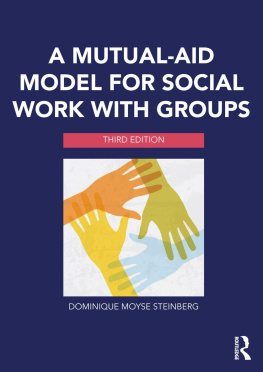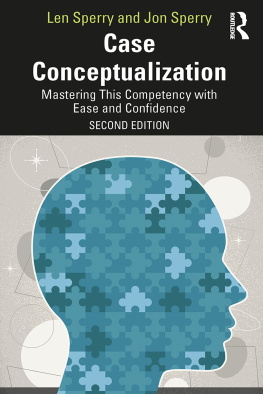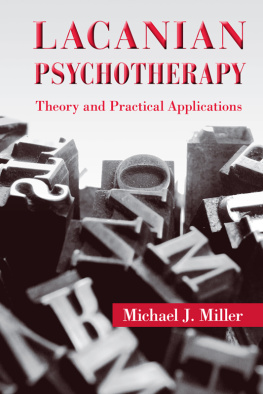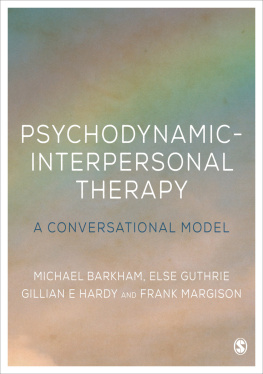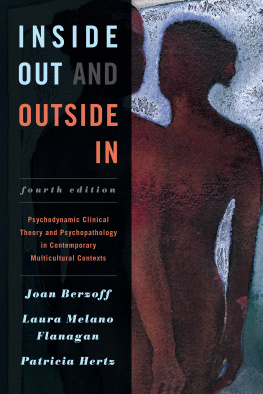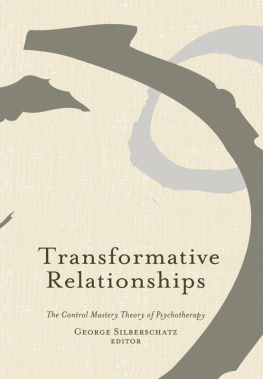Psychodynamic
Group Psychotherapy
FIFTH EDITION
J. Scott Rutan
Walter N. Stone
Joseph J. Shay

T HE G UILFORD P RESS
New York London
Epub Edition ISBN: 9781462516636; Kindle Edition ISBN: 9781462516643
2014 The Guilford Press
A Division of Guilford Publications, Inc.
72 Spring Street, New York, NY 10012
www.guilford.com
All rights reserved
No part of this book may be reproduced, translated, stored in a retrieval system, or transmitted, in any form or by any means, electronic, mechanical, photocopying, microfilming, recording, or otherwise, without written permission from the publisher.
Last digit is print number: 9 8 7 6 5 4 3 2 1
The authors have checked with sources believed to be reliable in their efforts to provide information that is complete and generally in accord with the standards of practice that are accepted at the time of publication. However, in view of the possibility of human error or changes in behavioral, mental health, or medical sciences, neither the authors, nor the editors and publisher, nor any other party who has been involved in the preparation or publication of this work warrants that the information contained herein is in every respect accurate or complete, and they are not responsible for any errors or omissions or the results obtained from the use of such information. Readers are encouraged to confirm the information contained in this book with other sources.
Library of Congress Cataloging-in-Publication Data
Rutan, J. Scott, author.
Psychodynamic group psychotherapy / J. Scott Rutan, Walter N. Stone,
Joseph J. Shay. Fifth edition.
p. ; cm.
Includes bibliographical references and indexes.
ISBN 978-1-4625-1650-6 (hardcover : alk. paper)
I. Stone, Walter N., author. II. Shay, Joseph J., author. III. Title.
[DNLM: 1. Psychotherapy, Groupmethods. 2. ProfessionalPatient Relations.
WM 430]
RC488
616.89152dc23
2014016619
J. Scott Rutan, PhD, is a psychologist in private practice in Chestnut Hill, Massachusetts. He is a Distinguished Fellow and past president of the American Group Psychotherapy Association (AGPA) and a Certified Group Psychotherapist. Dr. Rutan was the founder of the Center for Group Psychotherapy at Massachusetts General Hospital/Harvard Medical School and cofounder of the Boston Institute for Psychotherapy. He has published widely on group therapy and psychodynamic theory, conducts workshops around the world, and serves on the editorial boards of several journals.
Walter N. Stone, MD, is Professor Emeritus of Psychiatry at the University of Cincinnati College of Medicine and currently consults and teaches in Northern California. A Distinguished Fellow and past president of the AGPA and a Certified Group Psychotherapist, Dr. Stone has served as a board member and treasurer of the International Association for Group Psychotherapy and Group Processes. He has published widely on self psychological perspectives in group psychotherapy.
Joseph J. Shay, PhD, is a psychologist in private practice in Cambridge, Massachusetts. He is on the staff of the joint McLean/Massachusetts General Hospital (MGH) training program and has an appointment in the Department of Psychiatry at Harvard Medical School. He also serves on the faculties of the Northeastern Society for Group Psychotherapy, the Psychoanalytic Couple and Family Institute of New England, and the MGH Center for Psychodynamic Therapy and Research. A Fellow of the AGPA and a Certified Group Psychotherapist, Dr. Shay is a recipient of the Psychotherapy Supervision Award from the McLean/MGH residents in Adult Psychiatry. He has published widely on group therapy and couple therapy and serves on the editorial board of the International Journal of Group Psychotherapy.
Life is the only real counselor; wisdom unfiltered through personal experience does not become a part of the moral tissue.
E DITH W HARTON
T he fact that we are now presenting the fifth edition of this volume is a testament to the vibrancy of the group therapy model in addressing human suffering. This may be even truer today than it has been in the past because of the ways in which we are so interconnected on a daily basisor, for many people, so painfully disconnected.
We have come to understand that this disconnection not only results in suffering but also can have more dire consequences. Vaillant (2012), in the famous Grant Study that followed 268 men for many decades, was struck by one finding about a cohort of 31 men who had an impaired ability to be intimate with others. Of these 31, only 4 were still alive. In contrast, of the men who moved past this Eriksonian intimacy stage to the next stage, 50 of 128 were still alive. As Vaillant flatly states, being able to attach deeply is a matter of life or death (p. 179). This study suggests that no matter how successful or healthy one might be, one will not be happy without supportive and loving relationships.
When Psychodynamic Group Psychotherapy was first published in 1984, psychodynamic theory and therapy were extremely popular. As successive editions were published, psychodynamic therapy became viewed as dated, and was partially replaced by medications, manual-driven therapies, cognitive-behavioral therapy, and various forms of behavior therapy. Further, there was a press for empirical evidence of the effectiveness of psychotherapy, and this evidence usually gave significant weight to symptom reduction or disappearance. The effectiveness of psychodynamic therapy is not as easily measured as that of other therapies, in part because symptom reduction is not the only goal. Indeed, at times it is not a goal at all. For example, in many cases an increase in uncomfortable feelings, which would represent an adverse effect in other modalities, can be viewed as a positive in psychodynamic therapy because it signals a weakening of defenses and increased access to feelings previously hidden.
In 2012, the American Psychological Association approved a Resolution on the Recognition of Psychotherapy Effectiveness, in which it was concluded that the best research evidence conclusively shows that individual, group, and couple/family psychotherapy are effective for a broad range of disorders, symptoms, and problems with children, adolescents, adults, and older adults (see American Group Psychotherapy Association, 2007; Burlingame, Fuhriman, & Mosier, 2003). The resolution also noted that the research supports that psychotherapy, both group and individual models of clinical interventions, is effective treatment for individuals with disabilities (see Himelhoch et al., 2007; Vail & Xenakis, 2007).
Psychodynamic therapy continues to stage a comeback, in part stimulated by the failure of some of the other modalities to bring about enduring change, and partly because there are finally serious research data documenting the effectiveness of the model (Chiesa, 2010; Shedler, 2010; Gaudiano & Miller, 2013).
There is also a deeper awareness that human beings are relationally driven. Whereas classic Freudian theory implied that individuals are fundamentally narcissistic and interested in individual survival, modern psychodynamic theory begins with an assumption that we all strive to be in relationships. Consider Wallins (2007) articulation of this point:
I have identified three findings that appear to have the most profound and fertile implications for psychotherapy: first, that co-created relationships of attachment are the key context for development; second, that preverbal experience makes up the core of the developing self; and third, that the stance of the self toward experience predicts attachment security better than the facts of personal history themselves. (p. 1, emphasis in original)
Next page

